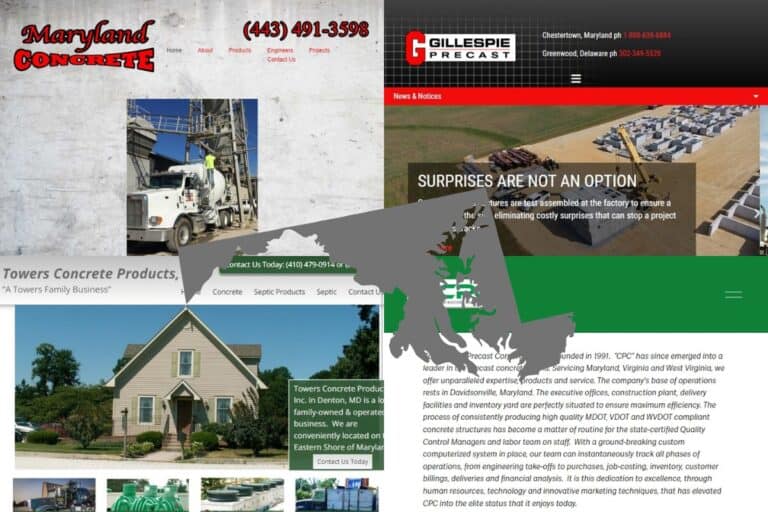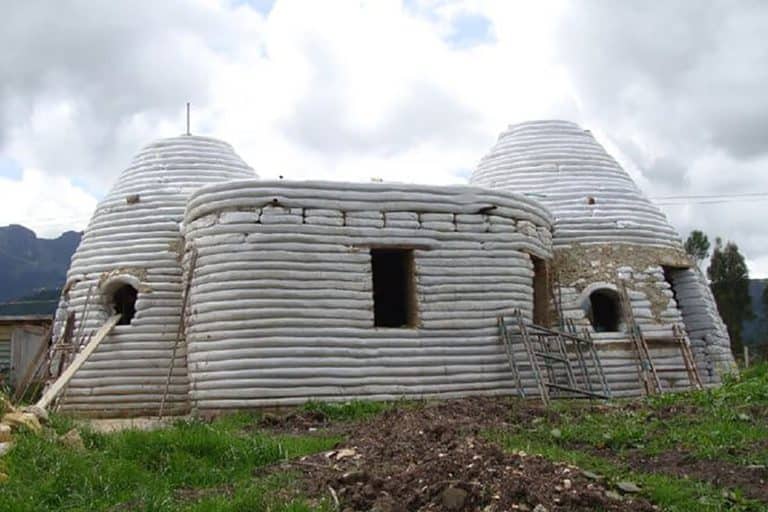The Top 15 Eco-Friendly Sustainable Buildings in Florida
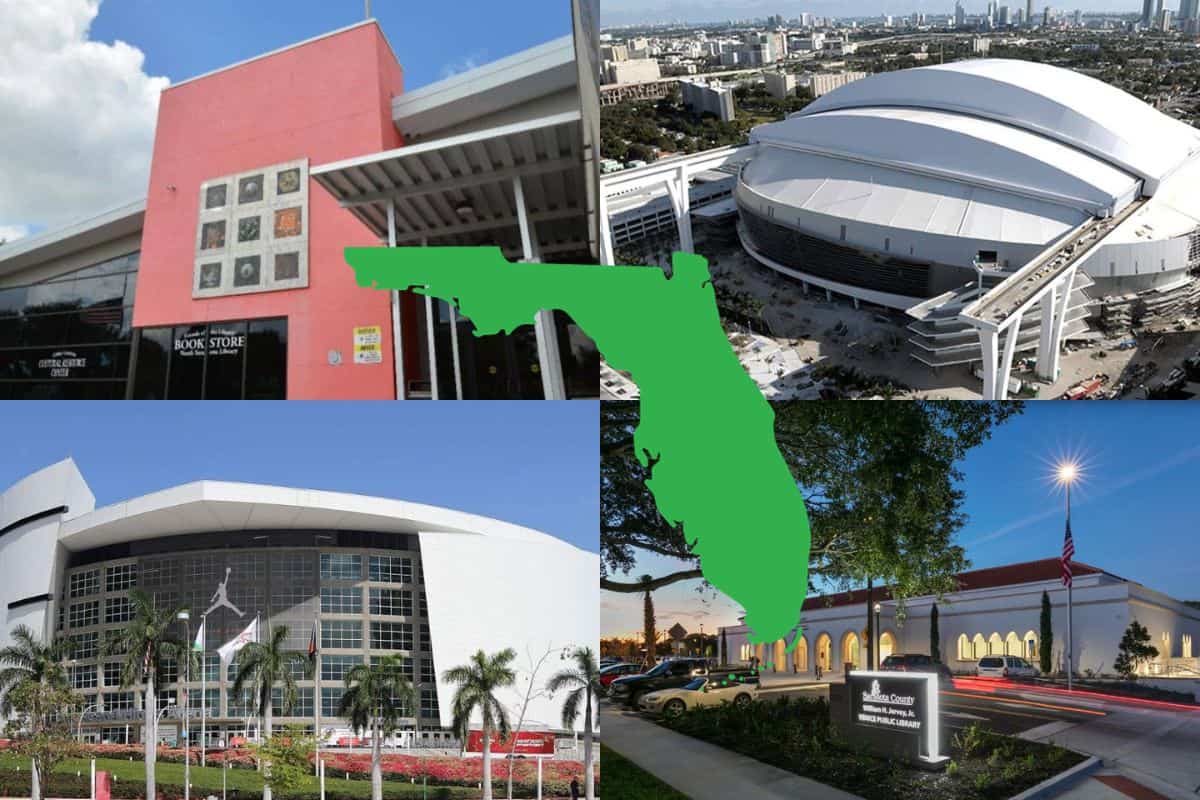
Images courtesy of The Sarasota News Leader, Uni-Systems Engineering, Inc, Tandem Construction, and jjron – Own work, GFDL 1.2, Link.
As a reader of this blog, you will likely share our concern about climate change’s impacts and human activity’s role in accelerating these effects.
It is crucial to acknowledge the importance of sustainable practices in our everyday lives, particularly within the construction sector, known for its significant environmental footprint. Florida, recognizing this, is leading the way with eco-friendly, sustainable buildings.
Let’s explore the top 15 structures, the epitome of modern design and aesthetics, that stand as beacons of sustainability and environmental consciousness.
Best Eco-Friendly Sustainable Buildings In Florida
The following is a compiled list of the 15 best sustainable buildings in Florida:
- Betty J. Johnson North Sarasota Library
- LoanDepot Park
- William H. Jervey, Jr. Venice Public Library
- Kaseya Center
- Phillip and Patricia Frost Museum of Science
- Lakeside Village
- Miami Herbert Business School
- Miami Herbert Business School
- Galaxy Elementary School
- Fairfield Manor
- UTC Center For Intelligent Buildings
- Largo Community Center
- KSC Headquarters Building
- Lynn Financial Center Office Buildings
- Perez Art Museum
- MetWest International
1. Betty J. Johnson North Sarasota Library
Building Type: Library
Location: Sarasota, Florida

The Betty J. Johnson North Sarasota Library is a haven for book lovers and a beacon of sustainability.
- The library is a model of water efficiency, incorporating Florida-Friendly Landscaping™ and a drip irrigation system, reducing water use for landscaping by half.
- Energy efficiency is another highlight of the library. It utilizes natural light to decrease energy use, while its HVAC system avoids using ozone-depleting substances.
- It hosts an active recycling program, utilizes recycled materials for 18% of the construction, and diverts 86% of construction waste from landfills.
- Low VOC finishes are used to minimize indoor air contamination, and there is no urea-formaldehyde in the composite wood used.
2. LoanDepot Park
Building Type: Stadium
Location: Miami, Florida
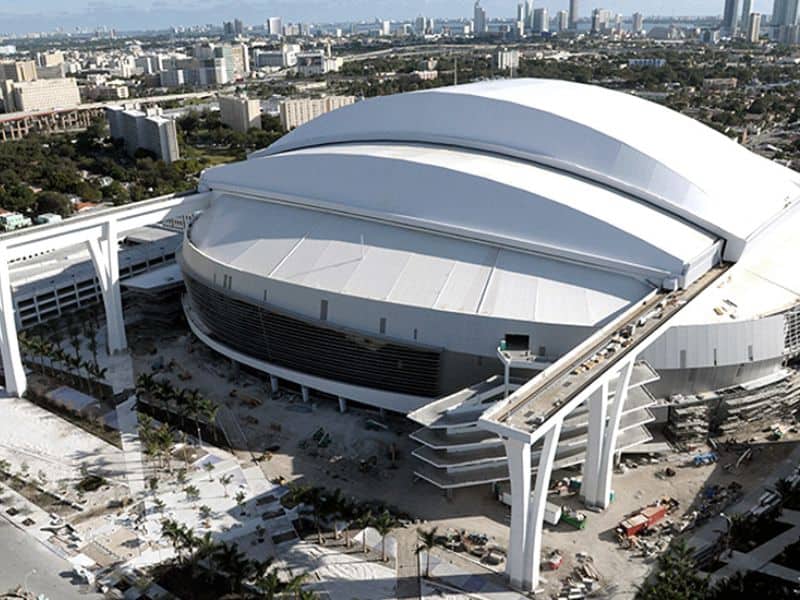
LoanDepot Park, the pioneering retractable-roof ballpark in Miami, embodies the principle of environmental sustainability in its design and operation in the following ways:
- Materials such as low-VOC sealants, paint, and adhesives were deliberately chosen to create healthy indoor air quality.
- The building combats the “heat-island effect” through a white rubber membrane that lines the roof, reflecting sun rays and reducing heat absorption.
- There is a conscious use of renewable resources, as evident by the choice of bamboo paneling in the suites instead of traditional hardwood.
- Much of the construction waste was recycled, demonstrating a commitment to minimizing landfill waste.
- The stadium is the first to achieve LEED Gold Certification, surpassing the initial goal of Silver Certification. This recognition makes it the most sustainable park in Major League Baseball (MLB).
- Despite the energy-intensive retractable roof, the park managed to attain a 22.4% reduction in energy usage, above the 14% required for certification. This was achieved by optimizing lighting, mechanical controls, and electrical aspects.
LoanDepot Park thus sets a new standard for eco-friendly architecture in stadiums. It showcases sustainable practices that make it a true standout among its peers.
3. William H. Jervey, Jr. Venice Public Library
Building Type: Library
Location: Venice, Florida
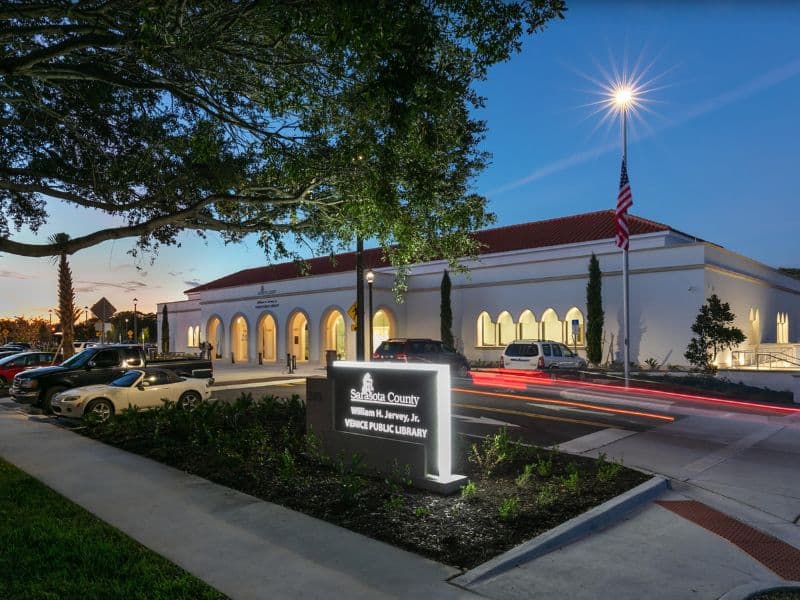
The William H. Jervey, Jr. Venice Public Library in Venice, Florida, showcases green and sustainable architecture.
The library uses HVAC and fire suppression systems free of harmful substances to promote energy efficiency. Efficiency upgrades have further reduced energy costs by 30%, and the library is designed to integrate photovoltaic panels easily.
Sustainable materials are prioritized, with 28% recycled content in construction materials and 17% sourced locally. Indoor air quality is maintained using low-VOC finishes and CO2 sensors. Energy-efficient LEDs are also used throughout the library for lighting.
The realization of this exceptional project was made possible through the expertise and collaboration of LEED-accredited professionals.
4. Kaseya Center
Building Type: Multi-Purpose Arena
Location: Miami, Florida
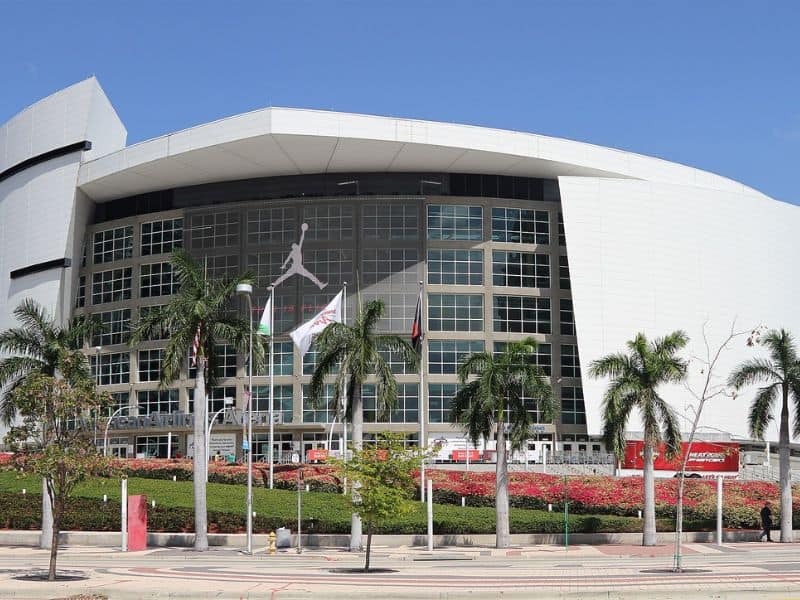
The Kaseya Center in Miami, Florida, was one of the first two venues in the country to receive LEED Certification for Existing Buildings.
Innovative materials are crucial to the center’s sustainability. The roofing material is highly reflective, repelling heat. The absence of an on-site chilled water plant further reduces energy consumption, and the underground parking facility helps minimize the heat-island effect.
Indoor air quality is also a focus, with walk-off carpets used to trap dirt and contaminants brought in by visitors. Combining these features ensures the Kaseya Center is a role model in sustainable and efficient building operations and maintenance practices.
5. Phillip and Patricia Frost Museum of Science
Building Type: Museum
Location: Miami, Florida
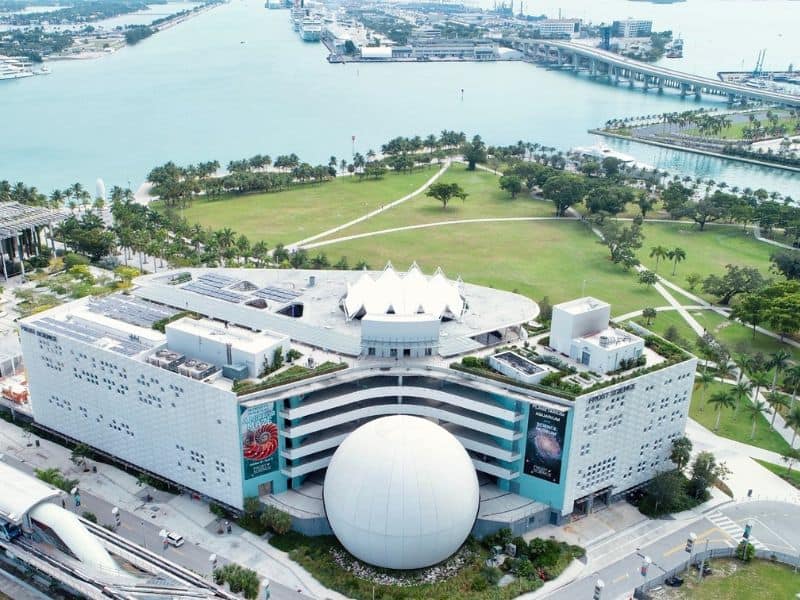
The Phillip and Patricia Frost Museum of Science in Miami, Florida, has earned a LEED Gold Certification, underlining its commitment to eco-friendly operations.
The following key features illuminate the museum’s focus on sustainability:
Construction and Materials: The museum focused on eco-friendly construction, utilizing resources and high-recycled-content materials. To reduce environmental impact, low chemical-emitting substances and paints were employed. An innovative green approach was taken by integrating “blast furnace slag” into the building as concrete technology.
Water Conservation: Frost Science has established an efficient water system to reduce wastage. This includes:
- Rainwater collection for HVAC makeup water and rooftop garden irrigation. This saves an estimated 350,000 gallons of city water annually.
- A gray water collection system for toilet and urinal flushing. Thus, conserving about 250,000 gallons of city water each year.
Energy Efficiency: The museum demonstrates a strong dedication to renewable energy. It has a rooftop solar farm with around 218 photovoltaic solar panels, generating about 2% of the building’s power needs.
6. Lakeside Village
Building Type: Housing Complex
Location: Miami, Florida
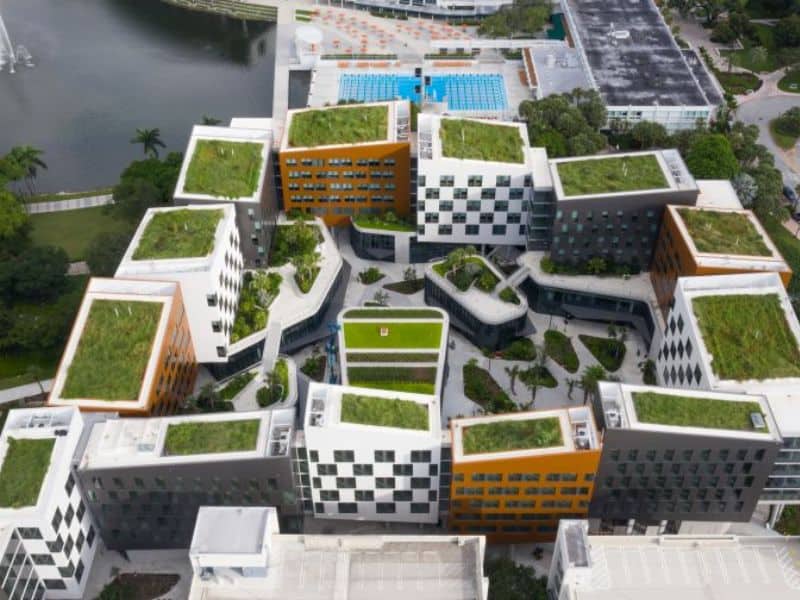
The Lakeside Village in Miami, Florida, is a model of sustainable student housing. It spans 12.4 acres and accommodates over a thousand students. The village seamlessly merges green architecture into the urban landscape.
It boasts extensive rooftop gardens covering 60,000 square feet across 26 interconnected buildings. These green roofs provide a habitat for pollinators and act as natural insulators.
Additionally, they aid water management by slowing down runoff and contributing to the rainwater harvesting system. This system irrigates the on-site rain garden.
These features maintain comfortable interior temperatures and reduce reliance on HVAC systems. Lakeside Village also demonstrates environmental stewardship by repurposing conditioned air and incorporating existing flora into the landscape.
7. Miami Herbert Business School
Building Type: Business School
Location: Coral Gables, Florida
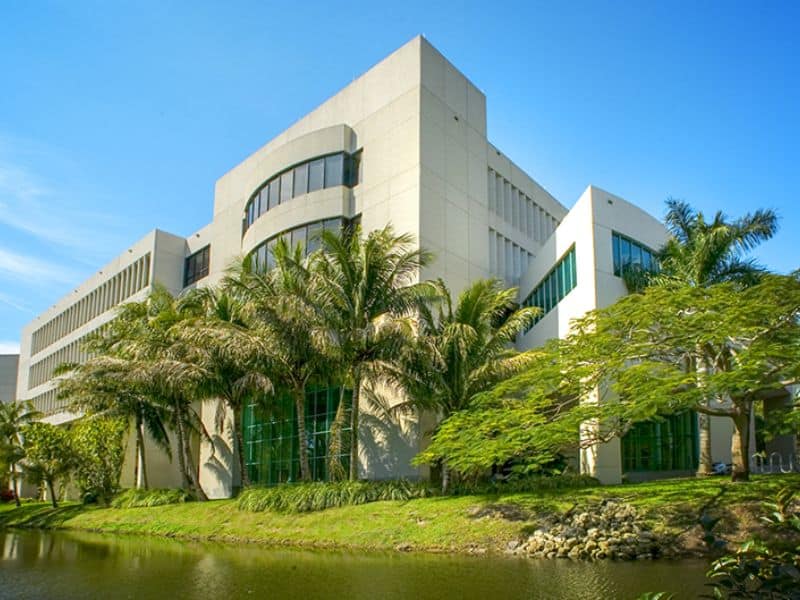
The Miami Herbert Business School has earned the distinction of a Leadership in Energy and Environmental Design (LEED) Platinum Certification for Operations and Maintenance (O&M) from the U.S. Green Building Council.
Key features contributing to this recognition include water savings, energy efficiency, waste reduction, and enhanced indoor environmental quality. Their participation in the SolarTogether program is noteworthy, significantly lowering greenhouse gas emissions.
Additionally, 54% of waste is diverted to recycling, recovery, or reuse facilities. The school saved 74,000 gallons of water and reduced energy use by 1.09M kBtu compared to 2019.
The building surpasses global and local averages for indoor environmental quality, ensuring the health and well-being of its occupants.
8. Galaxy Elementary School
Building Type: School
Location: Boynton Beach, Florida
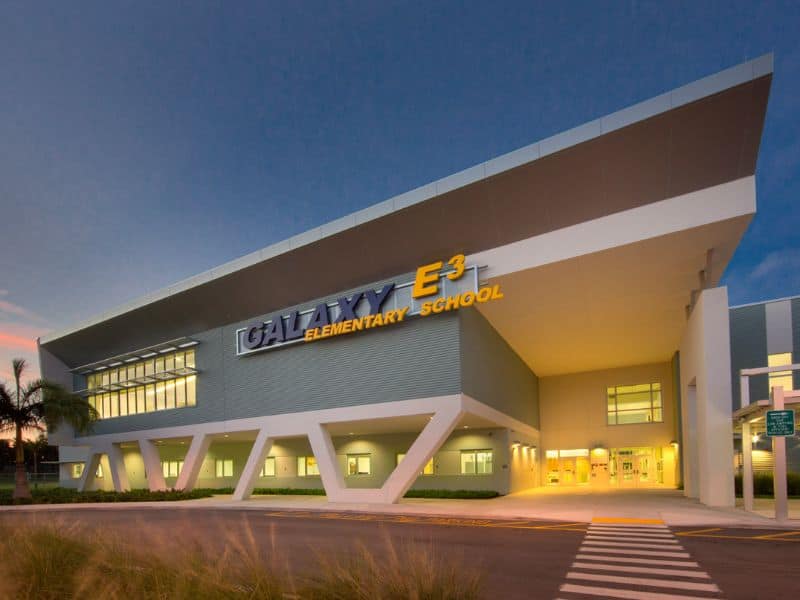
This 109,000-square-foot educational institution distinguishes itself through a variety of sustainable techniques:
- Green and White Roofs: The school utilizes a green roof for its natural insulation properties and a white reflective roof to decrease heat absorption and, thus, reduce cooling needs.
- Water Conservation: Installing waterless urinals epitomizes the school’s commitment to water conservation.
- Renewable Energy: The school harnesses wind turbines and solar power energy, reducing its reliance on non-renewable energy sources.
- Promotion of Electric Vehicles (EV): The provision of preferred parking for electric cars encourages the use of EVs among the school community.
- Natural Habitat: A 4-acre natural habitat serves as an outdoor classroom while nurturing local biodiversity.
- Thermal Energy Storage: IceBank® energy storage reduces operating costs and environmental impact. The school freezes water at night and melts it during the day, utilizing cleaner energy and reducing daytime consumption. This decreases demand on the power grid during peak times and optimizes renewable energy use. These strategies have successfully reduced the school’s peak energy consumption.
9. Fairfield Manor
Building Type: Apartment
Location: Pensacola, Florida
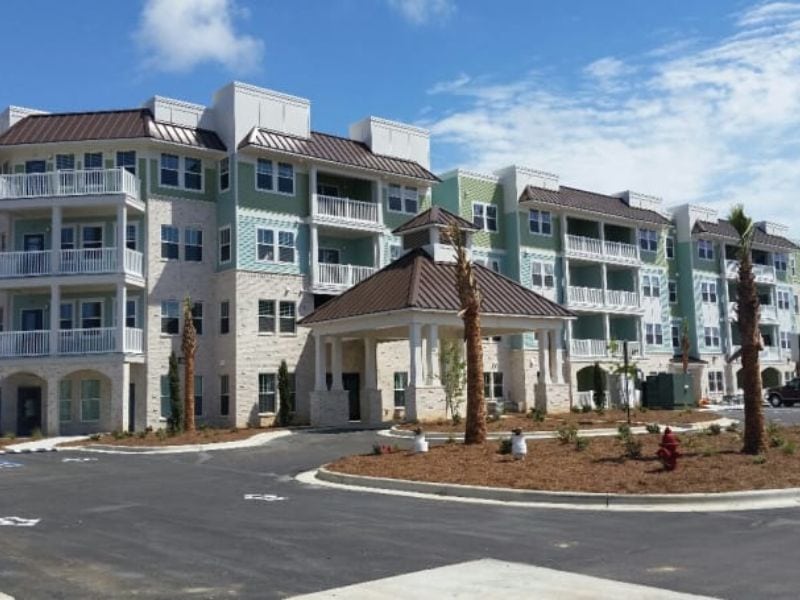
Fairfield Manor stakes its claim as an eco-friendly apartment complex focusing on affordable senior living. It stands out due to its comprehensive integration of sustainable design and construction strategies:
- Local Sourcing: A significant portion of the construction materials (75%) are locally sourced within a 75-mile radius. This boosts the local economy and reduces carbon emissions associated with the long-distance transportation of materials.
- Solar Energy: The Solar Photovoltaic system powers everything from elevators and corridor lighting to office appliances, ensuring a sustainable and efficient environment.
- Energy Efficiency: The apartments feature cutting-edge heating and cooling systems, high-efficiency water heaters, and ENERGY STAR-certified appliances.
- Water Conservation: The residential units are thoughtfully equipped with water-saving showers and plumbing fixtures, showcasing a steadfast dedication to preserving our precious water resources.
10. UTC Center For Intelligent Buildings
Building Type: Apartment
Location: Palm Beach Gardens, Florida
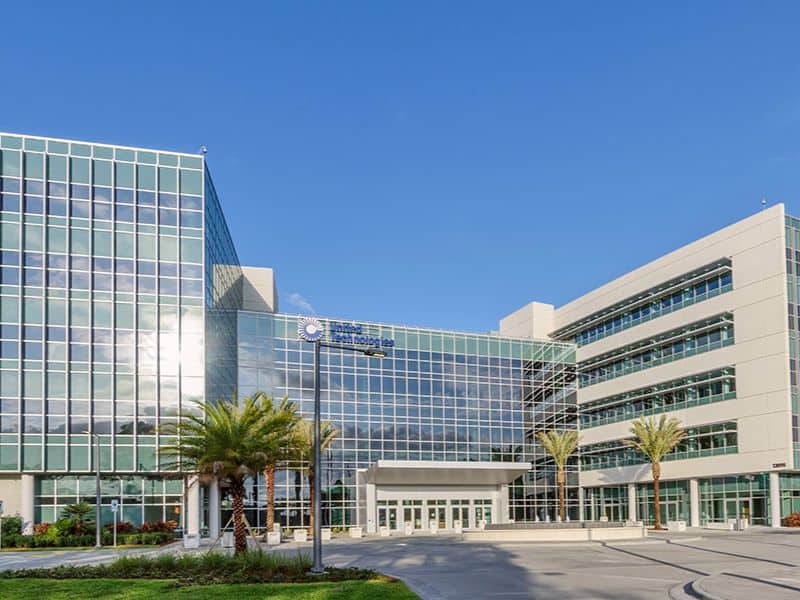
The UTC Center for Intelligent Buildings leads in sustainable structures with LEED Platinum® and WELL Platinum certifications. Designed for health and well-being, it is Florida’s first building to achieve this prestigious recognition. Its notable green features include:
- Energy Efficiency: Achieving a staggering 60% reduction in energy use. The building saves 6,240 MBtu annually, making it a powerhouse of energy efficiency.
- Carbon Footprint: The structures’ operation results in a 60% reduction of CO2 emissions, saving 988 tons annually. This breakthrough performance significantly minimizes the building’s carbon footprint.
- Water Conservation: The UTC Center is a paragon of water conservation, with a 100% reduction in outside water usage, saving 9,954,876 gallons per year. Additionally, indoor water use is curtailed by 36%, saving another 335,455 gallons annually.
11. Largo Community Center
Building Type: Community Center
Location: Largo, Florida
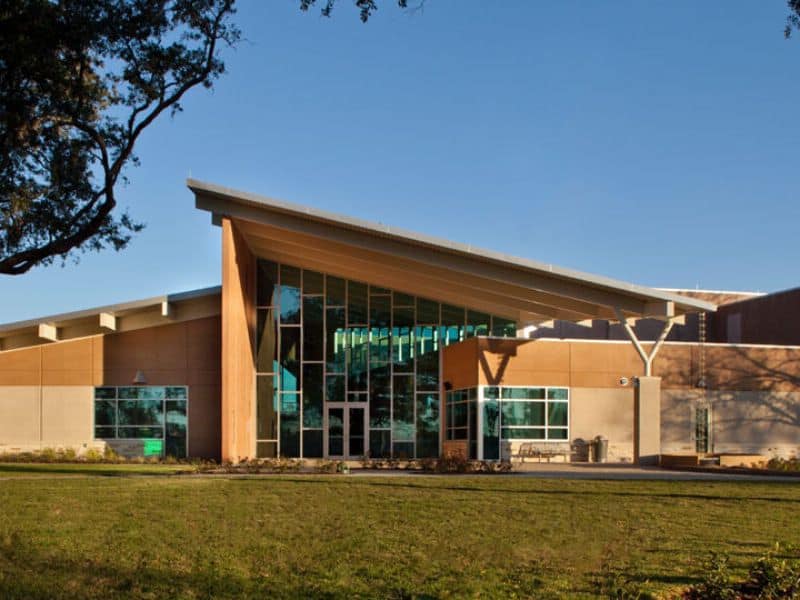
The Largo Community Center showcases the city’s commitment to sustainability. This LEED Platinum-certified building combines advanced technology with eco-conscious design. With a 30,000 square feet area, the center offers amenities like an art studio, ballroom, and fitness room.
What sets it apart is the innovative stormwater management system. Rainwater from the roof is used in fountains and irrigation, reducing the water footprint. The center harmoniously blends functional architecture with environmental stewardship.
12. KSC Headquarters Building
Building Type: Corporate Structure
Location: Merritt Island, Florida
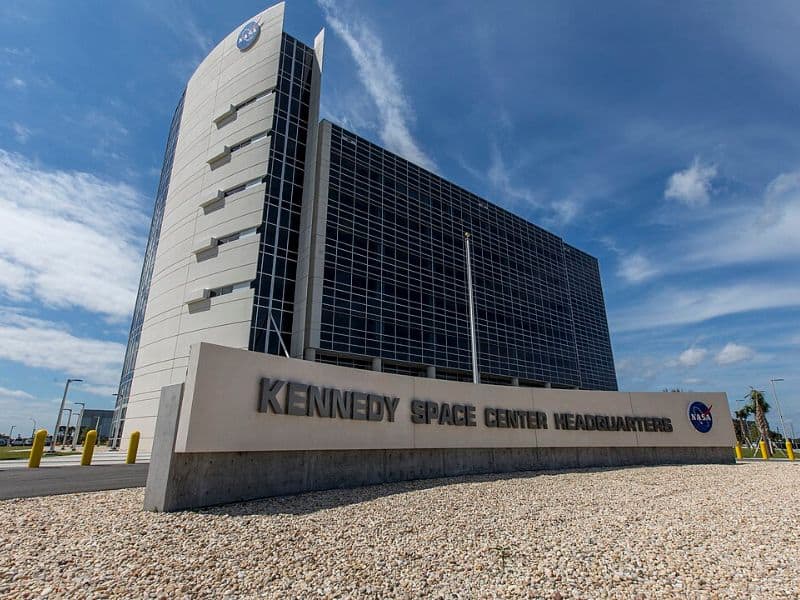
With Platinum certification under the LEED rating system, this building exemplifies a steadfast commitment to sustainable practices. Leveraging the power of natural light, the structure incorporates expansive north-facing windows that bathe the interior in diffused light. While south-facing windows feature built-in screens and sunshades to regulate direct sunlight.
The HVAC system employs chilled beam technology, minimizing the need for extensive ductwork and further enhancing energy efficiency. Occupancy sensors intelligently control lighting, ensuring that lights are only activated when necessary.
Demonstrating a strong sense of locality, the building’s landscape showcases native Florida plants. Moreover, the headquarters is powered by renewable energy from the KSC Photovoltaic Solar Farm, reducing reliance on the power grid. The construction process itself adhered to sustainability principles, with a remarkable 98% of construction waste being recycled.
13. Lynn Financial Center Office Buildings
Building Type: Corporate Structure
Location: Boca Raton, Florida
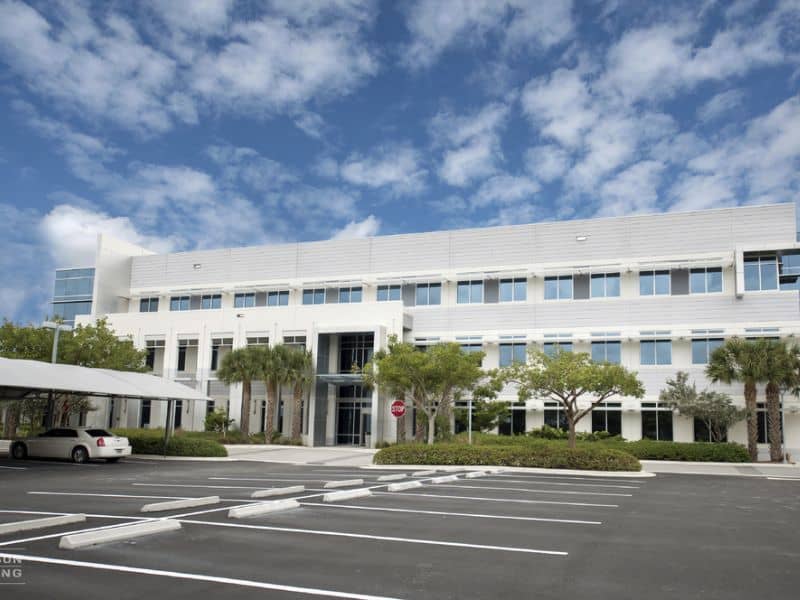
The Lynn Financial Center in Boca Raton, Florida, boasts an environmentally conscious design incorporating sustainable features. These include an underground reservoir that collects rainwater for irrigation and implementing water-conserving plumbing fixtures. These measures significantly reduce potable water consumption, showcasing the center’s commitment to sustainability.
These buildings are energy-efficient. Mechanical systems have been finely tuned for optimal operation during building commissioning. Strategically engineered metal solar screens, high-performance glass, and reflective roofing filters deflect intense South Florida sunlight, reducing the “heat island” effect and cooling loads.
To encourage eco-friendly commuting, the center offers showers and changing rooms for cyclists. It also provides preferred parking for approved low-emission vehicles, showcasing its commitment to sustainable design.
14. Perez Art Museum
Building Type: Museum
Location: Miami, Florida
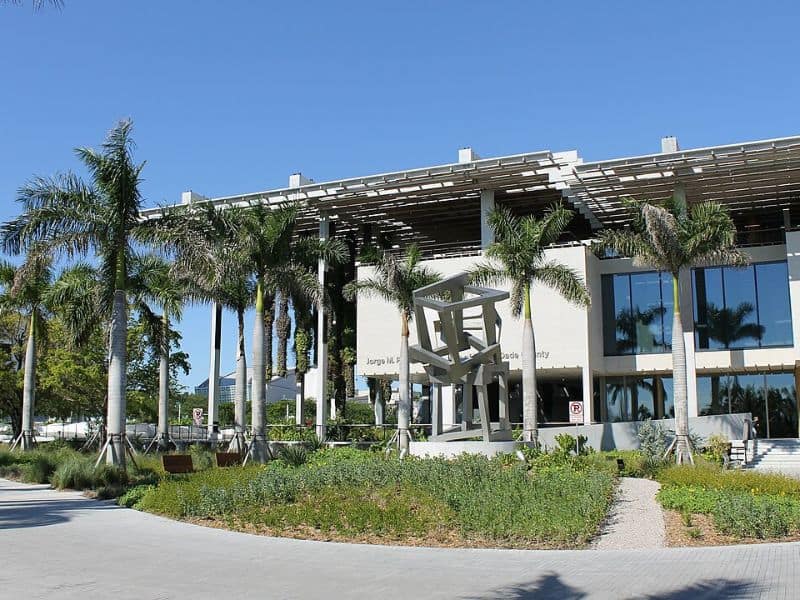
The Perez Art Museum in Miami, Florida, integrates various sustainable strategies into its modern design:
- Exterior Canopy: A standout feature of the museum, the expansive exterior canopy, also contributes to energy efficiency. By providing shade, it reduces the cooling load, thereby lowering energy consumption.
- Hanging Gardens: The museum’s hanging gardens, composed of native plants, serve dual purposes. They enhance the aesthetic appeal and contribute to water conservation by utilizing rainwater for irrigation.
- Energy Efficiency: Despite the need for strict climate control to preserve art, the museum aims to reduce energy costs by 20% compared to traditional museums. The underfloor air distribution system is key in achieving this goal, as it cools efficiently and consumes less energy.
- Underfloor Air System: This innovative system also results in lower velocity, fewer pressure drops, and reduced ductwork. It allows stratification, providing high-quality air at a low level and a comforting radiant cooling effect.
- Dehumidification: The museum employs waste heat recovery for dehumidification, adding another layer to its energy-efficient measures.
- Lighting: Maximizing natural light and efficient direct lighting in galleries reduces the need for artificial lighting. Integrating occupancy and daylight sensors in office spaces also ensures optimal lighting levels with minimal energy consumption.
These features demonstrate the Perez Art Museum’s commitment to marrying aesthetic appeal with sustainable design.
15. MetWest International
Building Type: Corporate Structure
Location: Tampa, Florida
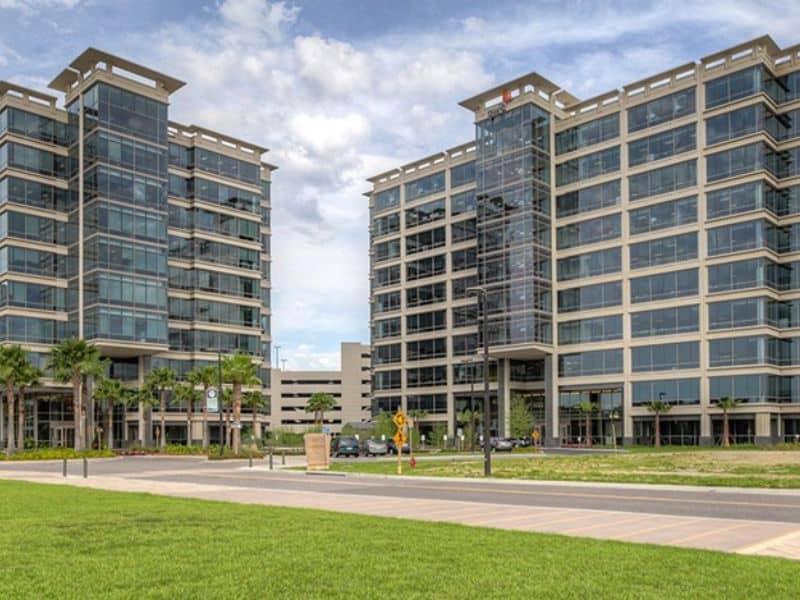
MetWest International is dedicated to environmental sustainability in its design and operations. The complex includes nearly a million square feet of Class A office space and incorporates various sustainable measures.
As part of its green initiatives, MetWest International efficiently manages stormwater. By capturing and storing it in retention ponds, the system recharges the aquifer naturally, reducing reliance on stormwater sewer systems.
MetWest is also committed to health and safety. An eco-friendly cleaning program minimizes exposure to hazardous substances, while LED lighting reduces energy consumption.
MetWest International demonstrates dedication to sustainable design and operations through innovative water management techniques. By using cooling towers and condensate recovery, significant water savings are achieved.
Final Thoughts
Across Florida, corporate structures, schools, museums, and other facilities are incorporating sustainable practices into their design.
From the KSC Headquarters Building in Merritt Island to MetWest International in Tampa, these green initiatives are committed to reducing resource dependence and improving environmental stewardship.
These projects serve as a great example for other states and countries, showcasing the potential of sustainable design when implemented correctly.



